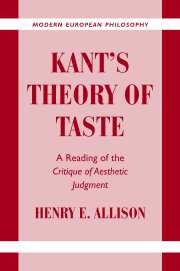Book contents
- Frontmatter
- Contents
- Acknowledgments
- Note on Sources and Key to Abbreviations and Translations
- Introduction
- PART I KANT'S CONCEPTION OF REFLECTIVE JUDGMENT
- PART II THE QUID FACTI AND THE QUID JURIS IN THE DOMAIN OF TASTE
- 3 The Analytic of the Beautiful and the Quid Facti: An Overview
- 4 The Disinterestedness of the Pure Judgment of Taste
- 5 Subjective Universality, the Universal Voice, and the Harmony of the Faculties
- 6 Beauty, Purposiveness, and Form
- 7 The Modality of Taste and the Sensus Communis
- 8 The Deduction of Pure Judgments of Taste
- PART III THE MORAL AND SYSTEMATIC SIGNIFICANCE OF TASTE
- PART IV PARERGA TO THE THEORY OF TASTE
- Notes
- Bibliography
- Index
5 - Subjective Universality, the Universal Voice, and the Harmony of the Faculties
Published online by Cambridge University Press: 18 January 2010
- Frontmatter
- Contents
- Acknowledgments
- Note on Sources and Key to Abbreviations and Translations
- Introduction
- PART I KANT'S CONCEPTION OF REFLECTIVE JUDGMENT
- PART II THE QUID FACTI AND THE QUID JURIS IN THE DOMAIN OF TASTE
- 3 The Analytic of the Beautiful and the Quid Facti: An Overview
- 4 The Disinterestedness of the Pure Judgment of Taste
- 5 Subjective Universality, the Universal Voice, and the Harmony of the Faculties
- 6 Beauty, Purposiveness, and Form
- 7 The Modality of Taste and the Sensus Communis
- 8 The Deduction of Pure Judgments of Taste
- PART III THE MORAL AND SYSTEMATIC SIGNIFICANCE OF TASTE
- PART IV PARERGA TO THE THEORY OF TASTE
- Notes
- Bibliography
- Index
Summary
The second moment has the dual task of explicating the “quantity” of judgments of taste, which Kant characterizes as a universality that is not based on concepts, and uncovering the subjective ground of such universality. The latter, as we have already seen, is located in the harmony (or lack thereof) of the imagination and understanding in their free play. Although Kant does not refer explicitly to pure judgments of taste within this moment, it is clear that he has them in mind, since, among judgments of taste, these are the ones that are thought to involve universality. Since the lack of a concept is a direct consequence of the aesthetic nature of such judgments, it is not really argued for again here. Nevertheless, we shall see that it plays a crucial role in both the explication of the universality thesis and the determination of the subjective ground of this universality.
The present chapter follows the structure of Kant's argument in the second moment and is composed of four parts, each one corresponding to a section of this moment. The first part analyzes the highly controversial derivation of the universality claim from the interest-independence affirmed in the first moment (§6). The second examines Kant's attempt to confirm the thesis that judgments of beauty necessarily involve such a claim through a comparison with the agreeable and the good (§7). The third considers Kant's account of the merely subjective nature of the universality in question, its connection with the idea of a universal voice, and the problem of erroneous judgments of taste that arises from the introduction of this idea (§8).
- Type
- Chapter
- Information
- Kant's Theory of TasteA Reading of the Critique of Aesthetic Judgment, pp. 98 - 118Publisher: Cambridge University PressPrint publication year: 2001

